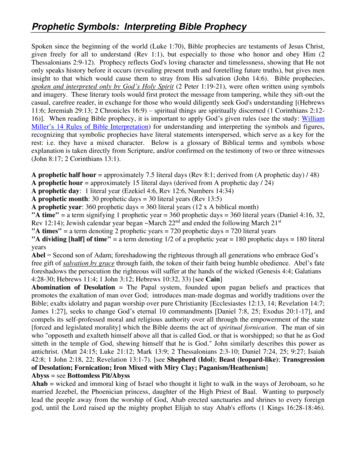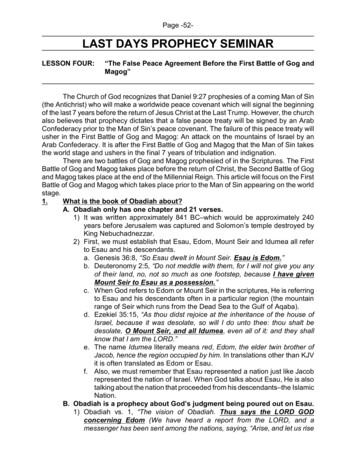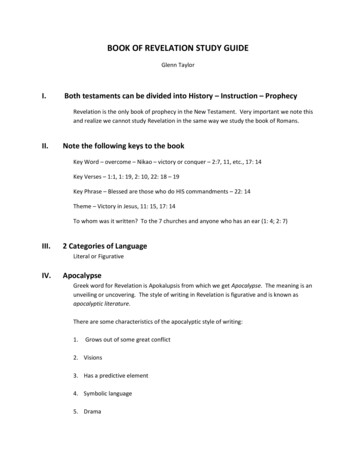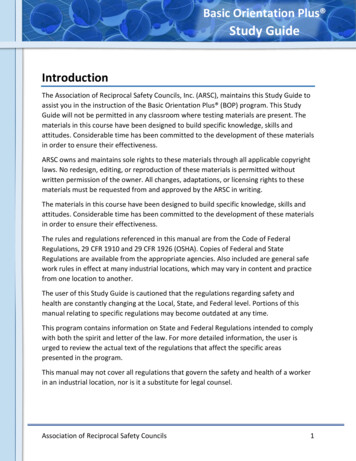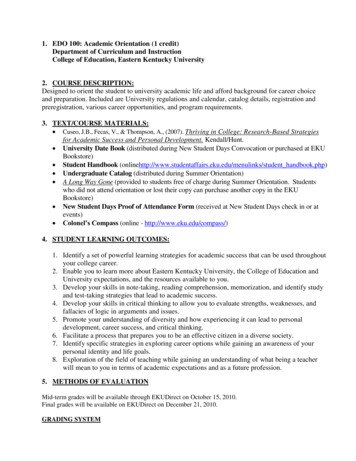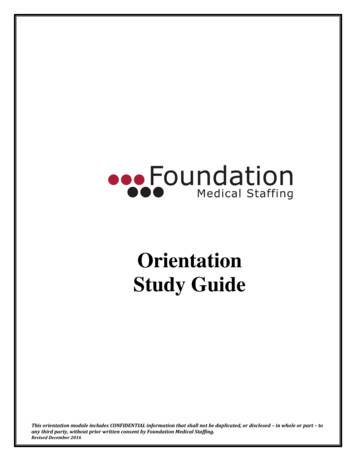
Transcription
OrientationStudy GuideThis orientation module includes CONFIDENTIAL information that shall not be duplicated, or disclosed – in whole or part – toany third party, without prior written consent by Foundation Medical Staffing.Revised December 2016
Table of ContentsINSTRUCTIONS . 2INFECTION CONTROL. 3AIDS AWARENESS . 10HEPATITIS B FACTS . 12HEPATITIS C FACTS . 13TUBERCULOSIS . 13ANTIBIOTIC-RESISTANT INFECTIONS . 15EBOLA VIRUS DISEASE . 18HAZARDOUS MATERIALS . 22BIOHAZARD SYMBOLS . 25BODY MECHANICS . 26ELECTRICAL SAFETY . 28FIRE SAFETY . 29GENERAL SAFETY GUIDELINES . 30EMERGENCY PREPAREDNESS . 30EMERGENCY MEDICAL TREATMENT AND ACTIVE LABOR ACT (EMTALA) . 32ETHICS OF CARE, TREATMENT, AND SERVICES . 33CMS AND CONDITIONS OF PARTICIPATION . 35JOINT COMMISSION 2017 NATIONAL PATIENT SAFETY GOALS . 35ORYX (NATIONAL HOSPITAL QUALITY MEASURES) . 47PREVENTING MEDICATION ERRORS. 48ABUSE IN PATIENTS . 50INFANT AND PEDIATRIC PATIENT ABDUCTION PREVENTION . 52CULTURAL DIVERSITY AND SENSITIVITY . 53AGE APPROPRIATE CARE . 56MANAGING THE DIFFICULT PATIENT . 58PATIENT RIGHTS AND ORGANIZATIONAL ETHICS . 59FRAUD AND ABUSE . 60RESTRAINT USE FOR NONVIOLENT, NON-BEHAVIORAL HEALTH PURPOSES . 63RESTRAINT AND SECLUSION FOR VIOLENT, SELF-DESTRUCTIVE BEHAVIORS . 64PAIN MANAGEMENT . 66ADVANCE DIRECTIVES. 67END OF LIFE CARE . 68SENTINEL EVENTS . 69SEXUAL HARASSMENT . 71WORKPLACE VIOLENCE . 74DRUGS IN THE WORKPLACE . 75WORKER’S COMPENSATION . 77HIPAA . 77Foundation Medical Staffing 20171
INSTRUCTIONSAll new travel employees will be required to take and pass the Orientation Test, prior to the firstday of their first assignment with Foundation Medical Staffing. Upon completion of the test,Foundation Medical Staffing will be given the answer sheet for each employee tested. Theanswer sheet must be signed by a manager and then placed in the employee’s credentialing file.A passing score of at least 80% must be attained. Re-testing will be required annually, thereafter,unless major changes have been made to the information contained in the Orientation test.Should major changes be made, all current employees will be required to re-take the test at thattime.You have 60 minutes to complete this test. The results of the test will be forwarded toFoundation Medical Staffing. In order to pass, you must answer at least 80% of the questionscorrectly. If you do not pass, a Foundation Medical Staffing representative will contact you.Foundation Medical Staffing 20172
INFECTION CONTROLHealth care-associated infections (HAI) are very serious and expensive issues in health care. They havebecome the most common complication of hospital care today. According to the Centers for DiseasePrevention and Control (CDC), about 1 in 25 hospital patients has at least one healthcare-associatedinfection. In 2011, there were an estimated 722,000 HAIs in U.S. acute care hospitals, more than halfoccurred outside of the intensive care unit, and of those about 75,000 hospital patients with HAIs diedduring their hospitalization. Ranked first for the most number of infections were pneumonia and surgicalsite infections from any inpatient surgery at 157,500 cases each, followed by gastrointestinal illness (suchas C. difficle) at 123,100, then urinary tract infections at 93,300, then primary bloodstream infections at71,900, and finally all other categories combined together were 118,500 (such as cardiovascular systemand bone and joint infections). The cost benefits of prevention of infections range from 5.7 billion dollarsto a high of 31 billion dollars.The CDC has stated that HAIs are a patient safety issue affecting all types of health care organizations.The Joint Commission concurred with the CDC’s concerns and has developed several National PatientSafety Goals that are specific to prevention and management of infections in healthcare settings. Theyhave added a new NPSG (NPSG.07.06.01) to the infection control section in 2012. The purpose for thisgoal is to implement evidence based practices to prevent indwelling catheter –associated urinary tractinfections (CAUTI). The three previous infection control targets for NPSG 7 were MDROs (multipledrug resistant organisms), central line associated infections and surgical site infections. These fourinfections have been associated with the highest numbers of HAIs and with the poorest outcomes forpatients when they occur.Because of the urgency of this issue, the CDC and The Joint Commission have developedrecommendations and policies for agencies. Every health care agency is required to develop infectionprevention and control programs to help reduce the possibility of acquiring and transmitting an infection.These programs should be comprehensive and address infection prevention and control across all levels ofthe health care setting. There is a four-step process for developing a risk based infection control plan.The first step is a thorough risk assessment based on current data and potential for infections. The secondstep is to develop specific goals to reduce the number of infections. The third step is the implementationof policies and procedures, and finally step four is a minimum of an annual evaluation of the riskassessment. The goals for the program should include: limiting unprotected exposure to pathogens,limiting the transmission of infections associated with procedures, limiting the transmission of infectionsassociated with medical equipment, devices and supplies, and improving compliance with hand hygieneguidelines. These goals should be developed from prevention and control activities that are based onevidence based national guidelines from the CDC/HICPAC or expert consensus. Essential elements forthe program should include: Involvement by the governing body and leadership team to ensure a culture of safety and qualitythroughout the hospital The designation by the leadership team of a certified infection control individual or team whohold the clinical authority for developing and implementing the daily management of infectionprevention and control activities Policies and procedures based on evidence based national guidelines and practice standardsdesigned to assess risk for infection and address control of infections and communicable diseases Staff, family, volunteer and patient education about infections and prevention A written plan to address an influx of potentially infectious patientsFoundation Medical Staffing 20173
Standard Precautions and Transmission Based precautions are guidelines that have been developedthrough evidence based practice to help reduce the risk of transmission of both recognized andunrecognized sources of infection in healthcare settings.Standard PrecautionsStandard precautions (previously called universal precautions) are a set of infection control practices usedto prevent transmission of diseases that can be acquired by contact with blood, body fluids, non-intactskin (including rashes), contaminated waste materials and mucous membranes. These measures are to beused when providing care to all individuals, whether or not they appear infectious or symptomatic. Asdefined by the CDC, Standard Precautions include all of the following: 1) hand hygiene, 2) use ofpersonal protective equipment, 3) safe injection practices, 4) safe handling of potentially contaminatedequipment, and 5) respiratory hygiene/cough etiquette. Hand HygieneHand hygiene refers to both washing with plain or anti-bacterial soap and water and to the use ofalcohol-based hand rub to decontaminate hands. When hands are not visibly soiled, alcoholbased hand rub is the preferred method of hand hygiene when providing health care to patients.When using a hand rub, it is important to remember to cover all surfaces of hands and fingerswith hand rubs and to rub until the hand rub is absorbed and dry.Hand hygiene should be performed before and after contact with a patient, immediately aftertouching blood, body fluids, non-intact skin, mucous membranes, or contaminated items (evenwhen gloves are wore during contact), immediately after removing gloves, when moving fromcontaminated sites to clean body sites during patient care, after touching objects and medicalequipment in the immediate patient-care vicinity, before eating, after using the restroom, and aftercoughing or sneezing into a tissue as part of respiratory hygiene.The World Health Organization’s guidelines for hand hygiene in healthcare are called “My fivemoments for hand hygiene.” The moments are focused around work flow zones of contact thatmight allow health care associated infections to occur.1. The first moment is before touching a patient. Hand hygiene at this moment will preventcolonization of the patient with health care associated microorganisms from the environmentto the patient through unclean hands.2. The second moment is before a clean/ aseptic/procedure such as a venipuncture, wound care,or injection. An exposure usually occurs here after touching skin, clothing or other patientobjects and then moving to perform one of the procedures. Even in procedures that requiregloves, hand hygiene should occur before donning gloves.3. The third moment occurs after a care task with body fluid exposure risk and requires handhygiene to be performed immediately before any next hand to surface exposure even withinthe same patient zone. This practice has a twofold purpose. First, it prevents the healthcareworker from being colonized with an infectious agent that may be present even if visiblesoiling is not present and secondly, it reduces the risk of transferring microorganisms from a“colonized” site to a clean body site on the same patient. When gloves are removed after theprocedures it is again recommended that hand hygiene occur.4. The fourth moment is after touching a patient. When leaving the patient zone after a caresequence and before touching an object in the area outside the patient zone in the health careenvironment, hand hygiene is required. This action prevents dissemination of microorganismsout into the HCWs (Health-care Workers) environment and in addition it protects thehealthcare workers themselves.Foundation Medical Staffing 20174
5. The fifth moment is after touching the patient’s surroundings. This moment is a variant ofnumber four. It requires hand hygiene after any exposure to a surface in the patient zone andbefore a subsequent hand exposure to any surface in the health care area but without touchingthe patient. Because hand exposure to patient objects, but without physical contact with thepatient, is associated with hand contamination, hand hygiene is still required. (WHOGuidelines on Hand Hygiene in Health Care, 2009) Personal Protective Equipment (PPE)Use of personal protective equipment (PPE) is mandated by the OSHA bloodborne pathogensfinal rule to reduce the risk of exposures to bloodborne pathogens under specified circumstances.PPE includes items such as gloves, gowns, masks, respirators, and eyewear used to create barriersthat protect skin, clothing, mucous membranes, and the respiratory tract from infectious agents.The items selected for use depend on the type of interaction a health worker will have with aclient and the likely modes of disease transmission.Gloves are worn to provide a protective barrier and to prevent gross contamination of the hands.They should be worn when in contact with blood, body fluids, secretions, excretions, non-intactskin, mucous membranes, and contaminated items. Gloves must always be worn during invasiveprocedures. Gloves do not replace the need for hand hygiene practices.Wear a surgical mask and goggles or face shield if there is a reasonable chance that a splash orspray of blood or body fluids may occur to the eyes, mouth, or nose such as myelograms, lumbarpunctures, spinal or epidural anesthesia, sputum inductions, bronchoscopies, etc.Wear a gown if skin or clothing is likely to be exposed to blood or body fluids through secretionsor excretions. Remove PPE immediately after use and wash hands. It is important to remove PPEin the proper order to prevent contamination of skin or clothing. The CDC has suggested stepsfor correctly donning and removing PPE. The proper order for donning PPE is: gown mask or respirator goggles or face shield gloves.The order for removing PPE is: gloves goggles or face shield gowns removed and rolled to the inside, masks or respirators being sure not to touch the front of the item.**Hand hygiene should be completed after removing all PPE.If PPE or other disposable items are saturated with blood or body fluids such that fluid may bepoured, squeezed, or dripped from the item, discard into a biohazard bag. PPE that is notsaturated may be placed directly in the trash. Saturated waste generated from the home should beplaced in sealable leak-proof plastic bags before placing in regular trash bags for disposal.The OSHA PPE Standards 1910.132 and 1910.133 require employers to provide PPE foremployees with hazard exposure in the workplace, train employees on the proper use of PPE, andproperly maintain, store, and dispose of PPE.Foundation Medical Staffing 20175
Safe Injection PracticesOutbreaks of hepatitis B and hepatitis C infections in US ambulatory care facilities haveprompted the need to re-emphasize safe injection practices. All health care personnel whogive injections should strictly adhere to the CDC recommendations Safe InjectionPractices which include: Use of a new needle and syringe every time a medication vial or IV bag is accessed Use of a new needle and syringe with each injection of a patient Using a multi-dose insulin pen for only one patient Using medication vials for one patient only, whenever possible If MDV (multidose vials) must be used, the needle and syringe used to access theMDV must be sterile and the rubber diaphragm must be cleaned with alcohol usingfriction. If multi-dose vials must be used for more than one patient, they should not be kept oraccessed in the immediate patient treatment area. This is to prevent inadvertentcontamination of the vial through direct or indirect contact with potentiallycontaminated surfaces or equipment that could then lead to infections in subsequentpatients. If a multi-dose vial enters the immediate patient treatment area, it should bededicated to that patient only and discarded after use (CDC, 2011). If MDV has been opened or accessed it should be dated and discarded within 28 daysunless the manufacturer specifies a different date for that opened vial. If MDV has notbeen opened then it should be discarded according to the manufacturer’s expiration date.Safe handling of needles and other sharp devices are components of standard precautionsthat are implemented to prevent health care worker exposure to bloodborne pathogens.The Needlestick Safety and Prevention Act mandates the use of sharps with engineeredsafety devices when suitable devices exist. The safety devices on needles and other sharps should be activated immediately afteruse. Used needles should be discarded immediately after use and not recapped, bent, romthe syringe or tube holder, or otherwise manipulated. Any used needles, lancets, or other contaminated sharps should be placed in a leakproof, puncture-resistant sharps container that is either red in color or labeled with abiohazard label. Only discard empty syringes. Unused medications and partial doses of medications,including controlled substances, should be wasted into an appropriate receptaclebefore the syringe is placed in the sharps container. Do not overfill sharps containers. Discard after 2/3 full or when contents are at the“full” line indicated on the containers. Used sharps containers may be taken to a collection facility such as an area pharmacy,hospital, or clinic that provides this service. Most agencies contract with a biohazards agencythat removes all waste based upon compliance standards.Sharp items should be disposed of in containers that are puncture resistant, leak-proof,closable, and labeled with the biohazard symbol or are red in color. Sharps containersshould be replaced when filled up to the indicated “full” line. Items generated by localpublic health agencies that should be discarded into sharps containers includecontaminated items that may easily cause cuts or punctures in the skin (used needles,lancets, broken glass or rigid plastic vials) and unused needles and lancets that are beingFoundation Medical Staffing 20176
discarded. Syringes or blood collection tube holders attached to needles must also bediscarded still attached to the needles. Surface Disinfection and Reusable EquipmentPatient care areas, common waiting areas, and other areas where patients may have potentiallycontaminated surfaces or objects that are frequently touched by staff and patients (doorknobs,sinks, toilets, other surfaces and items in close proximity to patients) should be cleaned routinelywith EPA registered disinfectants, following the manufacturers’ instructions for amount, dilution,and contact time. Departmental polices will outline the processes by which all equipment shouldbe cleaned and disinfected.Disinfectants included on the EPA List E have broad spectrum activity and are appropriatechoices for cleaning patient examination rooms and surfaces. Housekeeping surfaces such asfloors and walls do not need to be disinfected unless visibly soiled with blood or body fluids.They may be routinely cleaned with a detergent only or a detergent/disinfectant product. Surfacesin the patient room and environment should be cleaned daily and upon patient discharge ortransfer using an approved disinfectant.Most disinfectants are not effective in the presence of dirt and organic matter, therefore cleaningmust occur first before disinfection. Wet a cloth with the disinfectant, wipe away dirt and organicmaterial, then with a clean cloth apply the disinfectant to the item and allow to air dry for the timespecified by the product manufacturer.Some pathogens such as norovirus and Clostridium difficile are not inactivated by commercialdisinfectants routinely used in local public health settings. In situations where contaminationwith these pathogens is suspected, a bleach solution (1:10) is recommended for disinfectingcontaminated surfaces and items.Some patient care items may be damaged or destroyed by certain disinfectants. Consult with themanufacturer of the items before applying disinfectants. Respiratory Hygiene (Cough Etiquette)Patients in waiting rooms or other common areas can spread infections to others in the same areaor to staff. Measures to avoid spread of respiratory secretions should be promoted to help preventrespiratory disease transmission. Elements of respiratory hygiene and cough etiquette include: Covering the nose/mouth with a tissue when coughing or sneezing or using the crook of theelbow to contain respiratory droplets. Using tissues to contain respiratory secretions and discarding in the nearest waste receptacleafter use. Performing hand hygiene (hand washing with non-antimicrobial soap and water, alcoholbased hand rub, or antiseptic hand wash) immediately after contact with respiratory secretionsand contaminated objects/materials. Asking patients with signs and symptoms of respiratory illness to wear a surgical mask whilewaiting in common areas or placing them immediately in examination rooms or areas awayfrom others. Provide tissues and no-touch receptacles for used tissue disposal. Spacing seating in waiting areas at least three feet apart to minimize close contact amongpersons in those areas. Supplies such as tissues, waste baskets, alcohol gel, and surgical masks should be provided inwaiting and other common areas in local public health agencies. Place cough etiquette signswhere the general public can see them.Foundation Medical Staffing 20177
Waste DisposalNon-sharp disposable items saturated with blood or body fluids (i.e. fluid can be pouredor squeezed from the item or fluid is flaking or dripping from the item) should bediscarded into biohazard bags that are puncture resistant, leak-proof, and labeled with abiohazard symbol or red in color. Such items may include used PPE and disposable ragsor cloths.Local public health agency staff can transport infectious waste themselves or contractwith a waste hauler to collect and transport waste. Agencies that generate less than 50pounds of infectious waste per month do not need a license from the DNR to haulinfectious waste from their facility to a waste disposal site.A local public health agency that generates infectious waste is required to maintain a logof waste that is transported from the agency, regardless of the amount or how it istransported. The log must contain the following information: date of disposal, location towhich waste is transported, name of person transporting the waste, and the amount andtype of waste transported (e.g. three sharps containers, or five biohazard bags). Care mustbe taken to contain the waste during transport, keep waste separate from clean items inthe transport vehicle, and to clean and disinfect areas of the vehicle containing infectiouswaste before hauling clean items and materials.Transmission Based PrecautionsIn addition to Standard Precautions, a new set of Transmission-Based Precautions have been developed tobe used in addition to standard precautions when the route of transmission is not completely interruptedusing standard precautions. These patients may have documented or suspected infection or colonizationwith highly transmissible or epidemiologically important pathogens for which additional precautions areneeded to prevent transmission. There are three categories of transmission-based precautions: contactprecautions, droplet precautions and airborne precautions. Contact Isolation Precautions apply to patients with MDROs (multiple drug resistant organismssuch as Vancomycin Resistant Eenterococcus, C. Difficile, Noroviruses, RSV, MRSA, Scabies,Herpes Zoster and other intestinal tract pathogens), which are spread by direct or indirect contactwith the patient or the patient’s environment. These patients may have excessive wound drainage,fecal incontinence, or other discharges from the body, which suggest an increased potential forextensive environmental contamination and risk of transmission. A single room is preferred forthese patients and health care personnel caring for them should wear a gown and gloves uponentering the room and for all interactions that may involve contact with the patient or potentiallycontaminated areas in the patient’s environment. Dedicated disposable equipment should be usedwith the patient; if shared equipment is used it must be cleaned after each use. Discarding gownand gloves and cleaning hands before exiting the room is done to contain the pathogens. Iftransporting these patients, the patient should perform hand hygiene and then don a clean gown.The receiving area should be notified of the patient status. PPE should be worn during thetransport of the patient and removed when the transport is complete. Droplet Precautions are designed to reduce the risk of droplet transmission of infectious agents.Droplet transmission involves contact of the conjunctivae or the mucous membranes of the noseor mouth of a susceptible person with large particle droplets containing microorganismsgenerated from a person who exhibits a clinical disease or who is a carrier of the microorganism.The patient can generate these droplets from coughing, sneezing, and talking, as well as duringcertain procedures such as suctioning and bronchoscopy. Transmission via large droplets requiresFoundation Medical Staffing 20178
close contact (within 3 feet or less) between the source patient and the susceptible individual.Droplets (due to their large size) do not remain suspended in air and travel short distances - threefeet or less. Thus, droplet precautions require the use of a standard surgical mask within three feetof the patient. However, it is prudent to wear a mask upon entering the room of a patient ondroplet precautions to avoid any inadvertent exposure.Common organisms/diseases which require Droplet Precautions include:Bacterial: Invasive Haemophilus influenzae disease: meningitis, pneumonia (in infants and smallchildren), epiglottitis Invasive Neisseria meningitis disease, including meningitis, pneumonia, and bacteremia Pneumonia; Mycoplasma, adenovirus, meningococcal, strep Group A Group A Streptococcal pharyngitis, pneumonia, or scarlet fever in infants and young children Diptheria (pharyngeal) PertussisViral Influenza Adenovirus (requires Contact Precautions in addition) Mumps Parvovirus B19 RubellaThese patients are to remain in their rooms except when directed otherwise by Infection ControlPersonnel. They should wear a mask when they are out of their rooms. A gown and mask shouldbe worn upon entering the room and respiratory protection such as an N-95 respirator should beworn when performing high hazard procedures. Airborne precautions apply to patients known or suspected to be infected with epidemiologicallyimportant pathogens that can be transmitted by the airborne route. Airborne droplet nucleiconsist of small-particle residue (5 μm or smaller in size) of evaporated droplets that may remainsuspended in the air for a long time. Airborne transmission occurs by dissemination of eitherairborne droplet nuclei or dust particles containing the infectious agent. Microorganisms carriedin this manner can be widely dispersed by air currents and may be inhaled or deposited on asusceptible host from the source patient. Special air handling and ventilation are required toprevent airborne transmission. NPIR (negative pressure isolation rooms) are generally required.Doors to the rooms of these patients need to be kept closed. Staff working with these patientsneed to wash hands, don N95 respirator, gown and then gloves. When leaving the patient’s room,staff should remove the gloves then the gown and wash their hands before leaving the patient’sroom. After leaving the patients room, staff should shut the door, wash hands, remove therespirator and wash hands again. Examples of airborne diseases include measles (rubeola),anthrax, varicella zoster virus infections, Monkeypox virus, SARS Legionella infection,disseminated zoster, and tuberculosis.Health care organizations are required by the Occupational Safety and Health Administration (OSHA) totake strict precautions in prot
Study Guide. Foundation Medical Staffing 2017 1 . Foundation Medical Staffing will be given the answer sheet for each employee tested. The . Ranked first for the most number of infections were pneumonia and surgical site infections from any inpatient surgery at 157,500 c
